The 9 day cruise on the MS Magellan was so relaxing. The Magellan is one of Cruise & Maritime Voyages ships. An older and smaller ship holding just over 1200 passengers, had everything we needed. The staff don’t try to upsell everything, there was no pressure to spend extra money on-board. The ship left from Tilbury, London. Our first stop was Amsterdam, The Netherlands. It was fascinating going through the locks to enter the main docking area. With such a big ship there wasn’t much space between the ship and the lock wall.
The Ship was docked very close to the town centre, so it was just a short walk to be in the middle of the city. We did a free walking tour which took nearly 3 hours. The guide told us about the history of Amsterdam as well as The Netherlands. Also about marijuana and prostitution being legal here. We met in the Dam Square in front of the World War II National Monument. Here the guide told us about fishermen settled at the swampy mouth of the Amstel River almost 1000 years ago who built the first dam to protect their poor huts from the tides sweeping in. I don’t have a clue why they would want to settle in a place where they had to spend so much effort and money to protect their houses when they could go further East and settle where there was more stable ground. Yes, yes, I know you are saying that the other safer areas were already settled. I suppose this is how wars starts. Someone wants the better land, so they go and try and take the land from the existing owners. Who wins keeps the land. I am guessing, that these folks weren’t good fighters so they ended up having to build dams, so they could protect their homes built on swampy land. Looking at Amsterdam today, they did a pretty good job of protecting their houses, as the city is now a beautiful flourishing capital city of The Netherlands with a population of 780,000.
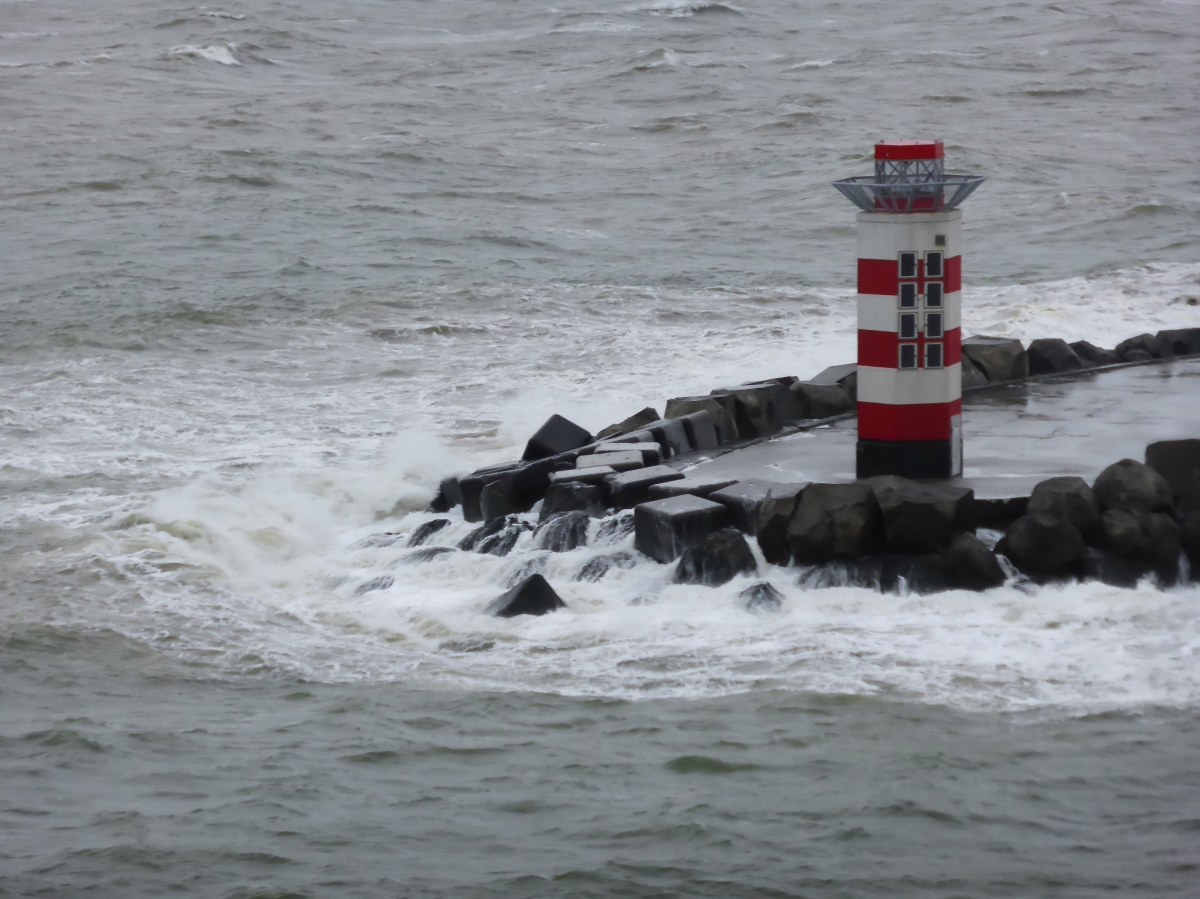
The oldest part of the city is the red light district. Walking through this area was ‘interesting’. Amsterdam is known as the most liberal city in the world. Prostitution is legal in brothels, but not on the streets. The Red Light District is a series of small alleyways with shop windows lining the sides. The women are behind the windows and have their own room. There are over 300 windows used for this purpose within three different Red Light Districts. We were also told that the prostitutes pay taxes. The first accounting practice I worked for in Perth, I had a prostitute as a client. I had to do some research to see what they can claim for as a deduction on their tax return! The Australian tax department actually has a tax code for the occupation of prostitutes.
There are many coffee shops around Amsterdam, as in all cities around the world, but ‘coffee shops’ here sell hash brownies and marijuana! There are about 250 coffee shops, where patrons can order and enjoy marijuana. If you only want coffee – go to a café. There is a special tolerance policy on soft drugs, but there are laws to follow: Possession of drugs is punishable, but max of 5 grams of weed or hash the police will just seize the drug. Over 5 grams you will be fined and risk a prison sentence. Growing weed at home is illegal, however 5 plants or less you can hand them over and you will generally not be prosecuted. Hard drugs are not allowed and import and export of hard drugs is illegal. You can smoke weed only in Amsterdam coffee shops. You must be over 18 and must show your passport or ID.
We were taken to a café (not a coffee shop) and given a sample of a famous Dutch chocolate sweet. Here they had a bench which had brown powder lined up so people can sniff the chocolate up their noses. Yuck. It is supposed to give you an instant sugar high. I prefer to eat my chocolate through my mouth.
The guide talked about the houses whose foundations needing replacing as the wooden beams have rotted; how people show they are rich by putting stairs leading to their front door; he showed us the narrowest building; the oldest wooden building in the city; he pointed out houses which are leaning due to the swampy ground and took us to the Begijnhof, which is a beautiful inner court surrounded by tall town-houses where beguines used to live. Beguines took a vow of chastity, and while they considered themselves obliged to attend Holy Mass every day and pray various official prayers, they enjoyed greater freedom than nuns in a convent and they were free to leave the court at any time to get married. There are two churches within the Begijnhof. The Catholic Houten Huys and the English Reformed Church.
A sinking house and the Begijnhof in Amsterdam.
I loved Amsterdam and it is definitely on my list of places to spend more time at.
Next stop was Hamburg, Germany where the ship docked overnight so we could spend 2 days there. Because the ship didn’t dock within walking distance to the city centre, they put on free shuttle buses.
Because Hamburg was a large port and industrial centre, Hamburg’s shipyards, U-boat pens, and the Hamburg-Harburg area oil refineries were severely bombed during World War II. This left the city in great need of rebuilding after the war. Now there is mainly building built after the war so the architecture is more modern than most European cities.
The got off the shuttle bus at the Rathausmarkt Square where the beautiful Hamburg Rathaus is. The Rathaus is the Town Hall and survived the WWII bombing. We had a look around the city centre with some friends we met on the ship. Lake Binnenalster is a beautiful lake. We decided to go for a walk around the lake. Half way around it started pouring with rain. Neal and I had disposable plastic raincoats but we still got wet. After dashing from shelter to shelter we ended up catching the bus back to the ship. The next day we went back into the city for another explore.
Aboard the Magellan we went to all the main shows. The singers in the productions were average, but the dancers were superb. We saw Don Reid, who is an English comedian. He is an old bloke with such a funny show. Some of his jokes were rude but not crude, if you know what I mean. As the ship’s home port is Tilbury and most of the passengers are from UK a lot of his jokes were based on life in the UK. A few of the jokes we didn’t quite understand but everyone around us was laughing so much that obviously you had to understand the UK social security system or be a Coronation Street fan. He did two shows, and both were great.
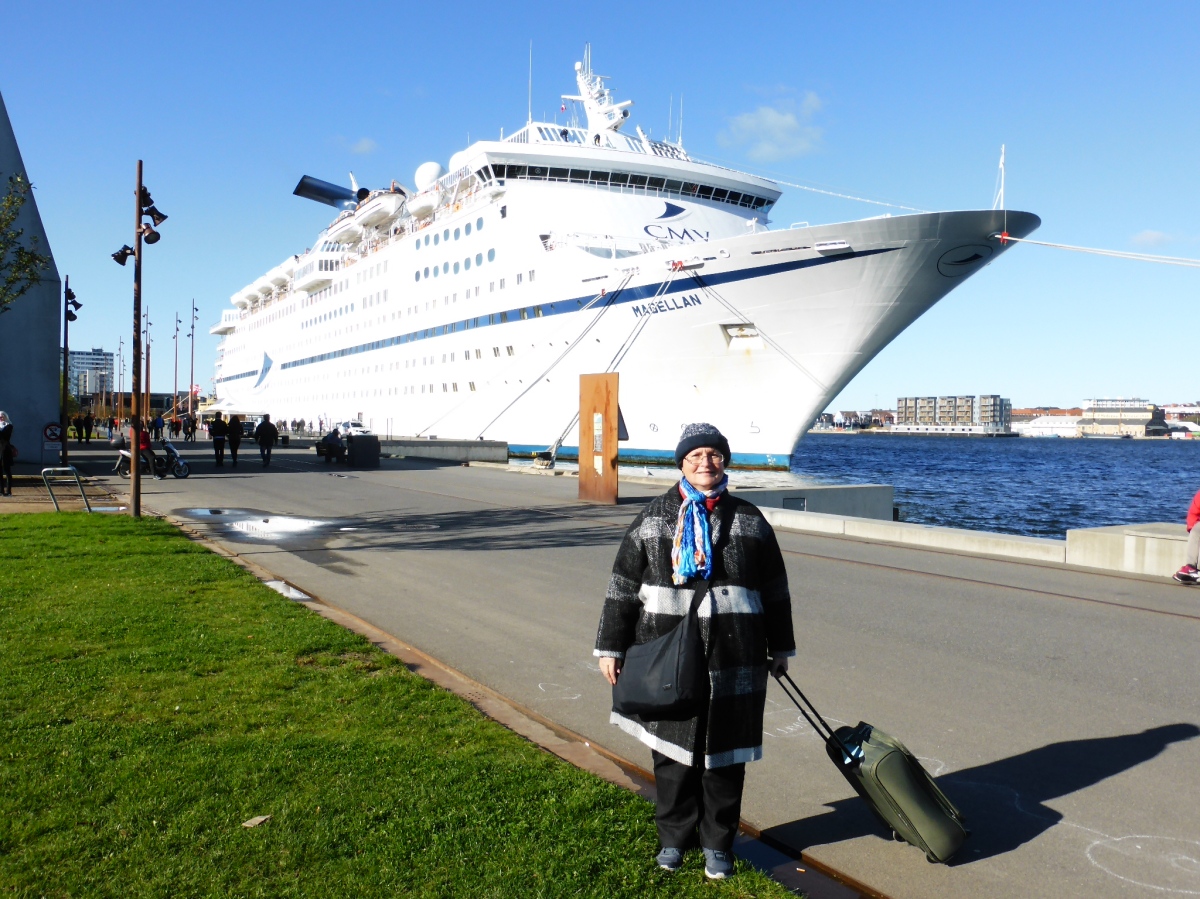
Our ship the Magellan at Aalborg which was very cold.
During the cruise Neal got the flu. It was a nasty one. He stayed in the cabin for the day, so he didn’t spread it around the ship anymore than it already was. I brought him down his food and anything else he wanted, and he got over it pretty quick. We met a nice bunch of people at our dinner table. One of the things I like about cruises, is that you meet people. At a hotel you may not meet anyone at all. Most people sit at the restaurant and not speak to anyone other than their travel companions. Also everyone on the ship are there for the same amount of time you are. Hotels, people come and go, so you may never see each other again. Over the years we have made a lot of friends on cruises and still keep in contact with.
Denmark is one of the countries I have always wanted to go to. We spent 2 days at Copenhagen. We docked walking distance to the town centre, so it was easy to explore. Of course, my number one sport was going to the Amalienborg Palace. Unfortunately, Princess Mary wasn’t home to have us for lunch. We forgot to tell her we were visiting, as I’m sure we would have been invited if she knew we were around. Mary, being a fellow Australian would have loved our company. Not that we know her, us Australians like to stick together. I could look after her dogs or cats for her if she had anyx. I’ll write and let her know that her guards did a fine job with the changing of the guards. Did I mention that the Danish Royal Family is the world’s oldest monarchy?  For those not in the know and who is interested, the present royal monarch is Queen Margrethe 2nd who is married to Prince Consort Henrik. The next in line is Crown Prince Frederik, who married Crown Princess Mary, who is an Aussie from Tasmania and they have 4 children: Christian, Isabella, Vincent and Josephine.
For those not in the know and who is interested, the present royal monarch is Queen Margrethe 2nd who is married to Prince Consort Henrik. The next in line is Crown Prince Frederik, who married Crown Princess Mary, who is an Aussie from Tasmania and they have 4 children: Christian, Isabella, Vincent and Josephine.
The changing of the guards took about an hour. At 10 minutes to 12 a group of young soldiers, known as life guards, marched out all ready to start the ceremony at 12 noon in the cobblestoned square outside. They waited at attention until a group of their comrades arrived to relieve them, after marching from their barracks at Rosenberg Castle. The guards wear bearskin hats. I am wondering where they get the bearskins from. Is there a farm of bears or do they use bears who have died of natural causes? Let me know by writing in the comments below if anyone knows the answer. Other countries use bearskin hats as well.
Denmark has a conscription for all physically fit men over 18, which can be for 4 – 12 months. Women may participate, but don’t have to. The minimal limit of participants is 4,200 at a time, so most don’t need to serve. In 2014, 99% were volunteers and only 19 men were compelled to serve. In the changing of the guards we watched there were women guards as well as men.
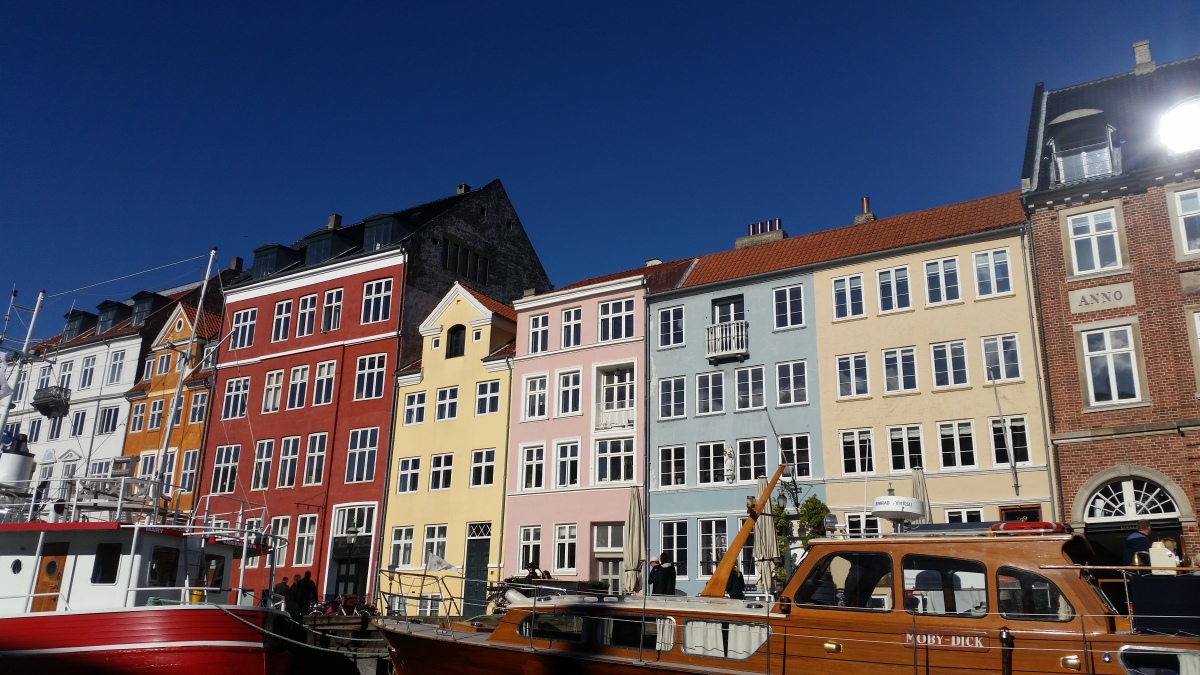
After seeing the changing of the guards we wandered down to the waterside when torrential rain and hail hit. Neal and I climbed up on a garden to shade under a tree. Other people copied. The hail was only small but the raindrops were larger. No-one had an idea it was going to rain. We were all caught by surprise. It only lasted about 4 minutes then stopped as quick as it started leaving many people dripping wet – but not us!
The Nyhavn and the boat tour of Copenhagen.
The Nyhavn is an area along a 300 year old canal which is lined with old sailing barges, restaurants and colourful buildings. From here we caught a boat to do some sightseeing around the canals. This is a fantastic way to see the city. We saw many interesting buildings, including the Opera House, the street food area, the Sixtus Battery, National Museum, National Library known as the Black Diamond, Stock Exchange, Gammel Strand, Christiansborg Palace (the parliament), Trekroner Fortress and lots of beautiful yachts and houses.
One of the most famous tourist attractions is The Little Mermaid sculpture. She was unveiled in 1913 as a gift from a Danish brewer Carl Jacobsen. Carl saw the ballet about the Little Mermaid and fell in love with the Hans Christian Andersen fairy tale. The sculpture is made of bronze and granite and is surprisingly small. It is a beautiful sculpture without a doubt, but why is it so famous? It’s a bit like when I saw the painting of Mona Lisa for the first time and I was surprised how small it was also. I read that the mermaid has several times had her head taken off and once the arm was sawn off, and several times she has had paint poured on her, but every time she is rescued and restored.
The little mermaid and Amalienborg Palace and Frederik’s Church .
Copenhagen didn’t let me down. I love it and want to return for a more thorough look sometime. It offers old and new architecture, waterways, open spaces, cobblestone narrow streets and also a Royal Family. The Danes have the world’s highest level of income equality and are frequently ranked as the happiest people and the least corrupt country in the world. What is there not to love? The weather!! – it is extremely cold. During the boat tour I got so cold that we had to sit in a warm café drinking tea to warm up so we could keep exploring. It is only Autumn! I can imagine winter is freezing.
Empty streets of Aalborg, Denmark.
We sailed next to Aalborg in Denmark. It was a public holiday in Denmark when we were there, so until 11am the only people around town were the homeless and other tourists from the ship. No special attractions here but it is a very pretty town. After 11 the shops opened and the locals started emerging from their heated homes. We found a warm café and sent out emails and used the internet.
I enjoyed the cruise and the destinations. The smaller ship was nice and best of all there were no children as only 18 year olds and older were allowed. The down side was there were lots of elderly.






















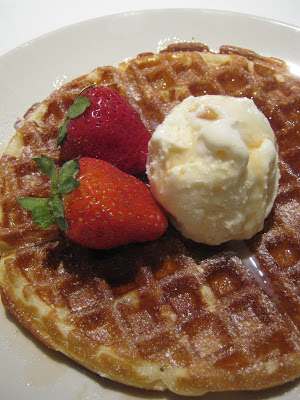 I wanted to have waffles for dinner. Nothing else, just waffles with strawberries and icecream. We eventually found a restaurant that was open and sold waffles. There were quite a few takeaway waffle stalls but their waffles are not so great as they didn’t have anything on top, and are just ‘too sweet’. If you want the whole experience of waffles you need to sit down and eat them off a plate, not walk around eating them like a hotdog. Neal talked me into having main course before the waffles, so I ordered carrot soup and Neal had lasagna; they were huge servings so afterwards we were too full to have any desert – so still no waffles! Walking back to the hostel, Neal was teasing me that I asked for waffles and he gave me carrots instead. HaHa. We discovered Belgium makes the world’s best hot Potato Chips. World famous due to their soft centre and crispy outside. They are especially served with mayonnaise (never tomato sauce). So yummy!
I wanted to have waffles for dinner. Nothing else, just waffles with strawberries and icecream. We eventually found a restaurant that was open and sold waffles. There were quite a few takeaway waffle stalls but their waffles are not so great as they didn’t have anything on top, and are just ‘too sweet’. If you want the whole experience of waffles you need to sit down and eat them off a plate, not walk around eating them like a hotdog. Neal talked me into having main course before the waffles, so I ordered carrot soup and Neal had lasagna; they were huge servings so afterwards we were too full to have any desert – so still no waffles! Walking back to the hostel, Neal was teasing me that I asked for waffles and he gave me carrots instead. HaHa. We discovered Belgium makes the world’s best hot Potato Chips. World famous due to their soft centre and crispy outside. They are especially served with mayonnaise (never tomato sauce). So yummy!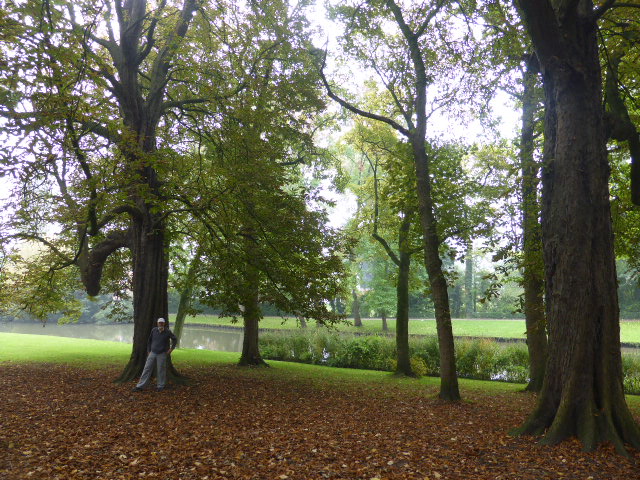












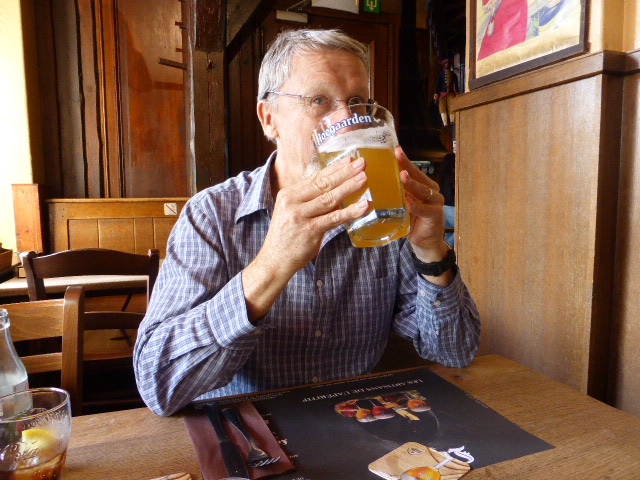






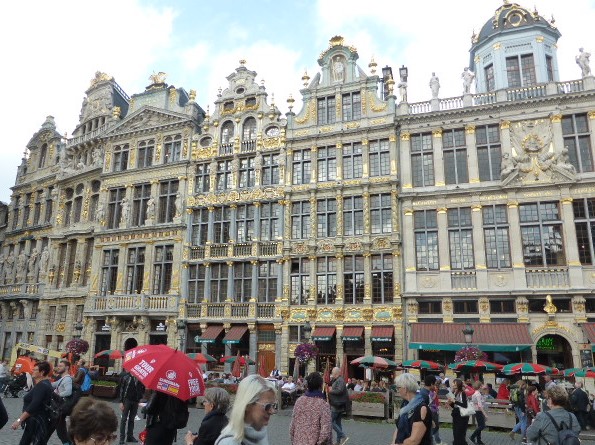






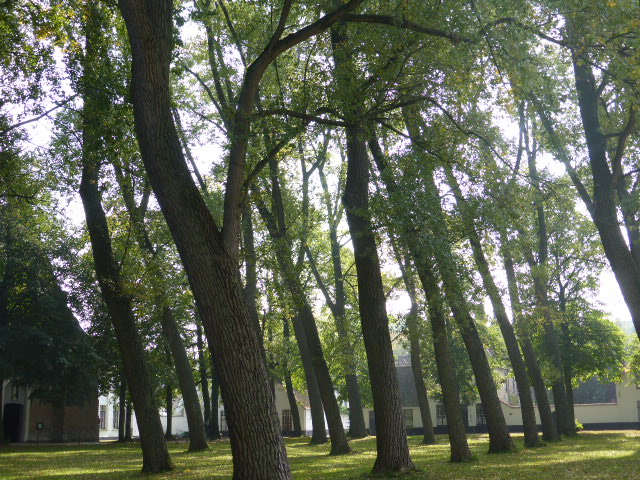


























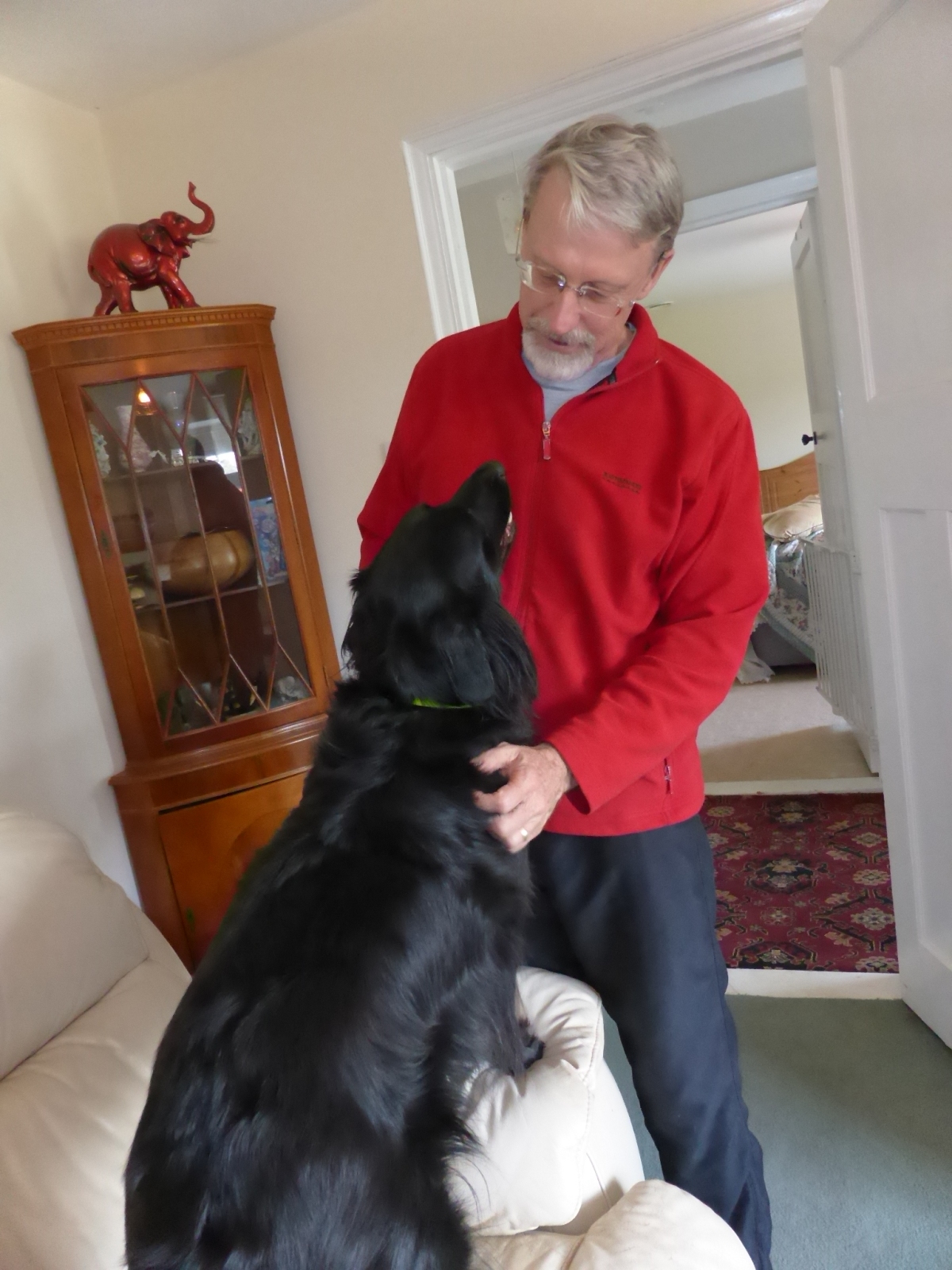
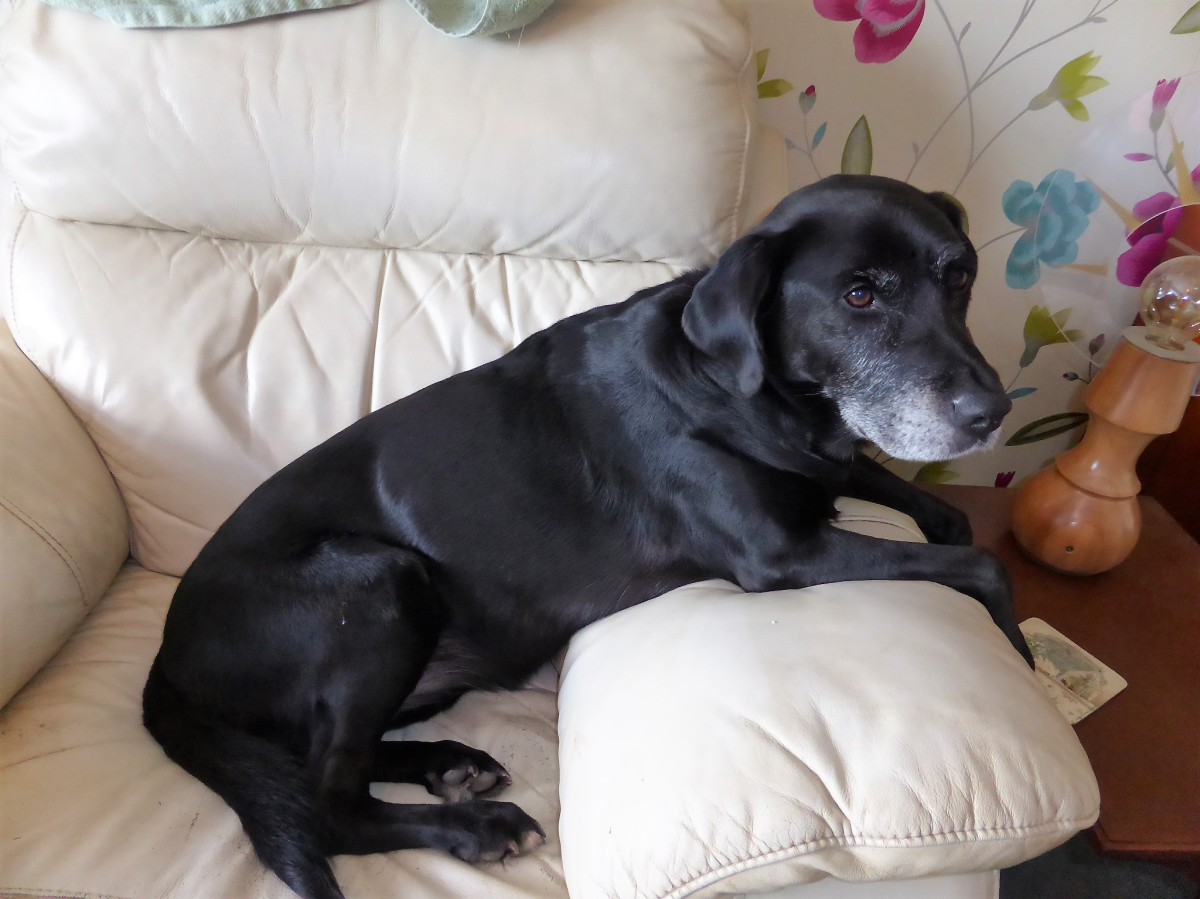


 Everywhere in England there are millions of hedges criss-crossing the countryside. Nearly all the roads are lined with hedges so, when driving we couldn’t see over the hedges to enjoy the scenery or even see what crops there were in the field next to the road. Most of these hedges are extremely high and close to the road edge – its like driving down a green tunnel. Apparently, there was legislation requiring the farmers to grow these hedges in years gone by. Also, a lot of the roads are so narrow that only one car could drive along the road at one time. This meant that travel could be very slow at times.
Everywhere in England there are millions of hedges criss-crossing the countryside. Nearly all the roads are lined with hedges so, when driving we couldn’t see over the hedges to enjoy the scenery or even see what crops there were in the field next to the road. Most of these hedges are extremely high and close to the road edge – its like driving down a green tunnel. Apparently, there was legislation requiring the farmers to grow these hedges in years gone by. Also, a lot of the roads are so narrow that only one car could drive along the road at one time. This meant that travel could be very slow at times.

